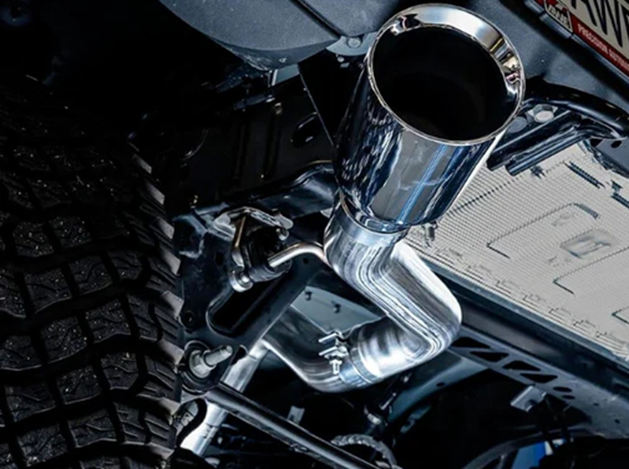Big, dependable and practical, trucks are best-sellers due to their limitless customization options. Roof racks, canopies and towing accessories increase storage and hauling capabilities. Good for transporting building materials to the worksite or packing everything for the family camping trip. But this isn’t where the appeal of pickup trucks ends. They’re also decently sprung to sling some mud and take you places other vehicles can’t. And if you’re after more fun on and off-road, the same truck can also take several performance mods, including aftermarket exhausts.
What Exhausts Do
Your truck’s factory exhaust expels spent gases from every combustion cycle, reduces engine noise to acceptable levels, and improves engine efficiency to potentially increase available horsepower. While stock systems adequately remove toxic pollutants, they’re also designed to a price point, with more corners cut. Individual parts feature multiple bends, the piping snakes around the engine bay, and the crush-bent mild steel will show its limitations when pushing the truck and the engine harder.
This creates several problems, especially if you’re looking to drain the last drop of power with other engine modifications. Bends and narrower tubing cause unneeded airflow restrictions, the mild steel can’t cope with higher temperatures and pressures (let alone punctures in typical off-roading), and the material is prone to corrosion and staining, spoiling the look of the vehicle. All this impacts engine and exhaust performance and longevity.
Why Consider Aftermarket Exhausts

There’s a whole list of benefits when you opt for aftermarket exhaust systems:
- Improved performance – reducing backpressure (or the lingering gases in exhaust tubes) results in more efficient combustion cycles. Expelling air through straighter and wider tubing means the engine can take its next breath. And the faster this happens, the more power the engine can produce. Full systems can add between 5 and 10 per cent of rated engine power, something that’s evident when accelerating, overtaking, and towing.
- Improved airflow – a byproduct is the improved airflow. Engines still remove pollutants, but without sacrificing power in the process. Smoother and faster airflow additionally means lower temperatures and pressure, or reduced stresses on exhaust pipe walls and related engine parts like exhaust valves, valve springs and cams.
- Better sound – with more space to move, spent gases produce a deeper, throatier exhaust note. The bigger the engine, the louder the sound. And this can be adjusted to personal preference with mufflers, resonators, straight pipes and other parts.
- Visual appeal and customization options – better designs, eye-catching materials, elaborate finishes, and attention to detail mean exhausts that add visual appeal to your truck. Modular configurations also lead to more customization and getting the expected results with parts that can be mixed and matched.
Common Layouts and Included Parts
When shopping for an aftermarket truck exhaust, consider your performance goals, driving style and budget. Is more power and torque important? Or are you drawn towards a rumbling engine sound? Different pre-assembled layouts in aftermarket exhaust systems mean choosing between axle-back, cat-back and full systems.
Axle-back types remove all factory parts from the rear axle to the tips, and include parts like high-flow mufflers or resonators to reduce exhaust drone. These pair with wider tail pipes and terminate in imposing tip designs to draw more attention. Their main purpose is to tailor the sound to specific tastes. As such, power and torque gains are negligible, but the lower purchase price and labor costs also mean this is a popular exhaust system choice.
Cat-back systems build on the improvements in axle-back exhausts with the addition of wider and straighter mid-pipes and more effective catalytic converters, or parts directly tasked with removing toxic exhaust gases. The layout significantly improves airflow and provides more horsepower and torque, especially in low-to-mid rev ranges where trucks excel. This also produces more substantial sound, particularly with less-restrictive straight pipes.
For the best power and torque gains, go with full exhaust systems. These can be header-back exhausts in aspirated engines, or turbo-back types in trucks with forced induction. Full systems have wider, revised headers and downpipes to draw out gases faster out of the combustion chamber in a process known as scavenging. Separate header pipes also terminate in a wider collector pipe to significantly boost airflow and increase combustion efficiency. Lower temperatures and faster airflow additionally boost performance, specifically by reducing wear and instances of turbo lag.
Materials, Diameters and Other Buying Considerations
Skip carbon or mild steel, and choose an aftermarket exhaust system made of mandrel-bent stainless steel. The material has higher tensile strength and higher heat resistance (or melting point) to sustain the consistent temperature extremes when flooring the gas. It also lasts longer, being more resistant to impact, such as in typical off-roading use, and won’t rust if you’re regularly driving in wet conditions. The production process ensures the piping retains uniform diameters throughout its length, with consistent airflow and reduced restrictions. Stainless steel systems are relatively affordable for what they offer, but for even better benefits, move up to titanium or carbon fiber.
The materials are a step up in terms of overall strength and come at a fraction of the weight. Titanium weighs half as less, is rust-resistant even without alloys or coatings, and the higher stiffness produces a unique exhaust note. Carbon fiber is a good alternative in exhaust tips, mainly due its distinct layered design, high heat and chemical resistance for increased durability and simple maintenance, with no discoloration or staining typical of steel.
For an exhaust compatible with your truck, ensure it comes in the right diamaters. Common aftermarket sizes (2.5. 3 and 3.5″) are compatible with most trucks in terms fo engine output, fit and balanced performance, specifically optimized airflow. Lastly, for easy installation, look to exhausts with provided hangers and clamps for a clean, vibration-free fit.


